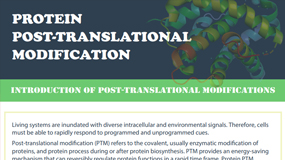N-Glycan Profiling Service
Creative Proteomics with expertise in analyzing glycosylation (N-Glycan Profiling and O-Glycan Profiling) from a variety of protein samples. We can conduct comprehensive analysis of N-glycan, including glycan composition, connection mode and site-specific information through advanced mass spectrometry technology and professional bioinformatics analysis platforms. Our professional team will provide customers with full support from sample preparation to result interpretation, helping you to deeply understand the role of glycosylation in biological functions and accelerate your research and development process.
Submit Your Request Now
×- Our Service
- Workflow
- Techniques
- Sample Requirements
- FAQ
- Publications
What Is N-Glycan Profiling?
N-glycosylation usually occurs at a specific motif in the protein sequence, namely Asn-X-Ser/Thr (X can be any amino acid except proline). N-Glycan Profiling is one of the most common types of post-translational modifications of proteins, analyzing the structure and composition of N-glycan in proteins, revealing the impact of glycosylation modifications on protein function, cell biology, and disease. As a critical quality attribute of biopharmaceuticals, N-Glycan profiling plays an import role in ensuring the quality and safety of biologics.
Our Advanced N-Glycan Profiling Service
We provide a variety of analytical methods for N-Glycan analysis, including but not limited to the mentioned below.
- Glycan structure identification
- Glycosylation site identification
- Glycan quantification
- Glycan sequence and linkage information
- Glycan heterogeneity
Contact us to learn more about how we can help in your project.
General N-Glycan Profiling Workflow
The general procedure of N-glycan analysis:
1. Sample preparation
Protein sample is extracted from the target protein or protein mixtures. There will be purification and concentration steps of the protein to ensure the accuracy and efficiency of the N-glycan profiling analysis.
2. Release of N-glycan
The protein sample is treated with a specific enzyme (such as PNGase F) to release the covalently attached N-glycan.
3. Glycan purification
The released N-glycan may need to be further purified by chromatography or other methods to remove proteins, peptides, and other substances that may interfere with the analysis.
4. Labeling (optional)
To improve the sensitivity and resolution of detection, the purified N-glycan can be fluorescently labeled. (2-AB)
5. Separation and detection
N-glycans are separated and detected using techniques such as high-performance liquid chromatography (HPLC), capillary electrophoresis (CE), or mass spectrometry (MS). Providing qualitative and quantitative information of the glycans.
6. Data analysis
Conduct in-depth analysis of the acquired data.
Techniques For N-glycan Profiling
MALDI-TOF-MS
Advantages: Suitable for high throughput detection and highly sensitive for the structural characterization of glycosylated compounds.
Commonly used to analyze N-glycan in some biological samples such as plasma, cells and tissues.
 Figure 1. MALDI-TOF-MS results confirm the modulation of N-glycans from lactoferrin linked with MIE-NH2 [1]
Figure 1. MALDI-TOF-MS results confirm the modulation of N-glycans from lactoferrin linked with MIE-NH2 [1]
HILIC-UHPLC-MS
Advantages: Separation of glycans by hydrophilic interaction chromatography and detected by MS. Suitable for the analysis of a large number of samples and can provide detailed N-glycan structure information.
 Figure 2. Overlaid total ion current chromatograms (TICCs) of RapiFluor-MS labelled IgG N-glycans from a patient with MOGS-CDG (red line) and control (black line) by HILIC-UPLC-ESI-MS [2]
Figure 2. Overlaid total ion current chromatograms (TICCs) of RapiFluor-MS labelled IgG N-glycans from a patient with MOGS-CDG (red line) and control (black line) by HILIC-UPLC-ESI-MS [2]
CE-MS
Advantages: Suitable for analyzing low-abundance and similar N-glycans, and for resolving the heterogeneity of N-glycans with high resolution using minimal samples.
 Figure 3. N-Glycan isomer differentiation by CE-MS [3]
Figure 3. N-Glycan isomer differentiation by CE-MS [3]
What Samples We Analyze?
Biopharmaceuticals: Antibodies, peptide vaccines, Fc fusion proteins, etc.
Biological samples: Plasma, tissues, fluids, cell supernatant, lysate etc.
Other: Sialic acids, microbial polysaccharides, plant proteins, etc.
In addition to the samples listed above, we have rich experience in analyzing samples from a variety of sources, please contact us to discuss the feasibility of your samples.
FAQ
What are the applications of N-glycan profiling?
Biomedical research: Used for the development and quality control of biopharmaceuticals (such as therapeutic monoclonal antibodies).
Disease diagnosis and research: Some of the diseases affect the glycan pattern on the cell surface, N-glycan analysis plays an important role in the disease markers identification and mechanism research.
Cell biology and immunology: Analysis of changes in glycan on the cell surface helps understand cell-to-cell interactions and signal transduction.
How to choose a suitable protein sample?
Choose high-purity, high-concentration protein sample to avoid interference from impurities. For low-abundance protein, enrichment is recommended (such as immunoprecipitation).
Why do we need to label glycan?
Labeling glycan improves detection sensitivity (such as fluorescence or mass spectrometry detection)
What are the technical challenges of N-glycan profiling?
Complex structure: The glycan structure is complex, increasing the difficulty of analysis.
Low abundance and low ionization efficiency: Glycan is low abundance and low ionization efficiency in mass spectrometry, which affects the detection sensitivity.
Sample volume requirements: Traditional glycomics analysis usually requires a large amount of sample, which is a challenge for trace sample analysis.
Learn about other Q&A.
N-Glycan Profiling Case Study
Publications
Here are some publications in Glycomics research from our clients:

- Conformational differences between functional human immunodeficiency virus envelope glycoprotein trimers and stabilized soluble trimers. 2019. https://doi.org/10.1128/jvi.01709-18
- Identification of the O-Glycan Epitope Targeted by the Anti-Human Carcinoma Monoclonal Antibody (mAb) NEO-201. 2022. https://doi.org/10.3390/cancers14204999
- Alternative glycosylation controls endoplasmic reticulum dynamics and tubular extension in mammalian cells. 2021. https://doi.org/10.1126/sciadv.abe8349
- Modulation of the Endomembrane System by the Anticancer Natural Product Superstolide/ZJ-101. 2023. https://doi.org/10.3390/ijms24119575
References
- Senan, A.M.; et al. Modification and characterization of lactoferrin-iron free with methylimidazolium N-ethylamine ionic liquid as potential drugs anti SARS-CoV-2. Engineering Proceedings. 2023, 37(1):14. https://doi.org/10.3390/ECP2023-14701
- Messina A.; et al. HILIC-UPLC-MS for high throughput and isomeric N-glycan separation and characterization in congenital disorders glycosylation and human diseases. Glycoconjugate Journal. 2021, 38(2):201-211. https://doi.org/10.1007/s10719-020-09947-7
- Wagt S.; et al. N-Glycan isomer differentiation by zero flow capillary electrophoresis coupled to mass spectrometry. Analytical Chemistry. 2022, 94(38):12954-12959. https://doi.org/10.1021/acs.analchem.2c02840






















